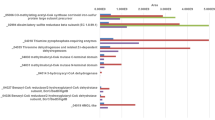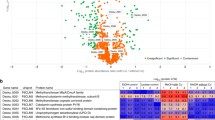Abstract
A sulfate reducing bacterium isolated from sewage sludge was capable of degrading methanol after growth on pyruvate, malate, or fumarate. 14C-Methanol was completely oxidized to carbon dioxide but not incorporated into the cellular material. The organism is a member of the genus Desulfovibrio.
Similar content being viewed by others
References
Banat JM, Nedwell DB, Balba MT (1983) Stimulation of methanogenesis by slurries of saltmarsh sediment after the addition of molybdate to inhibit sulphate reducing bacteria. J Gen Microbiol 129:123–129
Bergmeyer HU (1974) Methoden der enzymatischen Analyse. Verlag Chemie, Weinheim
Braun M, Schoberth S, Gottschalk G (1979) Enumeration of bacteria forming acetate from H2 and CO2 in anaerobic habitats. Arch Microbiol 120:201–204
Buchanan RE, Gibbons NE (1974) Bergey's manual of determinative bacteriology, 8th edition. Williams and Wilkins, Baltimore
Devol AH (1983) Methane oxidation rates in the anaerobic sediments of Saanich Inlet. Limnol Oceanogr 28:738–742
Howard BH, Hungate RE (1976) Desulfovibrio of the sheep rumen. Appl Environ Microbiol 32:598–602
Hungate RE (1969) A roll tube method for cultivation of strict anaerobes. In: Norris JR, Ribbons DW (eds) Methods in microbiology, vol 3 B. Academic Press, New York, 117–132
King GM, Klug MJ, Loveley DR (1983) Metabolism of acetate, methanol, and methylated amines in intertidal sediments of Lowes Cove, Maine. Appl Environ Microbiol 45:1848–1853
Loveley DR, Klug MJ (1983) Methanogenesis from methanol and methylamines and acetogenesis from hydrogen and carbon dioxide in the sediments of a eutrophic lake. Appl Environ Microbiol 45:1310–1315
Oremland RS, Polcin S (1982) Methanogenesis and sulfate reduction competitive and noncompetitive substrates in estuarine sediments. Appl Environ Microbiol 44:1270–1276
Oremland RS, Marsh LM, Polcin S (1982) Methane production and simultaneous sulphate reduction in anoxic, salt marsh sediments. Nature 296:143–145
Pfennig N, Widdel F, Trüper HG (1981) The dissimilatory sulfatereducing bacteria. In: Starr MP, Stolp H, Trüper HG, Balows A, Schlegel HG (eds) The Prokaryotes. Springer, Berlin Heidelberg New York 74:926–940
Postgate JR (1979) The sulfate-reducing bacteria. Cambridge University Press, Cambridge
Postgate JR, Campbell LL (1966) Classification of Desulfovibrio species, the nonsporulating sulfate-reducing bacteria. Bacteriol Rev 30:732–738
Rauschenbach P, Schmidt H-L, Simon H, Tykva R, Wenzel M (1974) Messung von radioaktiven und stabilen Isotopen. In: Simon H (ed) Anwendung von Isotopen in der Organischen Chemie und Biochemie, vol II. Springer, Berlin Heidelberg New York, p 104
Rode LM, Genthner BRS, Bryant MP (1981) Syntrophic association by cocultures of the methanol-and CO2−H2-utilizing species Eubacterium limosum and pectin-fermenting Lachnospira multiparus during growth in a pectin medium. Appl Environ Microbiol 42:20–22
Schink B, Zeikus JG (1980) Microbial methanol formation: a major end product of pectin metabolism. Curr Microbiol 4:387–389
Schink B, Zeikus JG (1982) Microbial ecology of pectin decomposition in anoxic lake sediments. J Gen Microbiol 128:393–404
Schink B, Zeikus JG (1983) Clostridium thermosulfurogenes sp. nov. a new thermophile that produces elemental sulphur from thiosulphate. J Gen Microbiol 129:1149–1154
Sorokin YJ (1966) Sources of energy and carbon for biosynthesis in sulfate-reducing bacteria. Mikrobiologiya 35:643–647 (translated)
Widdel F (1980) Anaerober Abbau von Fettsäuren und Benzoeäure durch neu isolierte Arten sulfat-reduzierender Bakterien. Dissertation, Univ Göttingen
Wolin EA, Wolfe RS, Wolin MJ (1964) Viologen dye inhibition of methane formation by Methanobacillus omelianskii. J Bacteriol 87:993–998
Zehnder AJB, Wuhrmann K (1976) Titanium III citrate as a nontoxic oxidation-reduction buffering system for the culture of obligate anaerobes. Science 194:1165–1166
Author information
Authors and Affiliations
Rights and permissions
About this article
Cite this article
Braun, M., Stolp, H. Degradation of methanol by a sulfate reducing bacterium. Arch. Microbiol. 142, 77–80 (1985). https://doi.org/10.1007/BF00409241
Received:
Accepted:
Issue Date:
DOI: https://doi.org/10.1007/BF00409241




